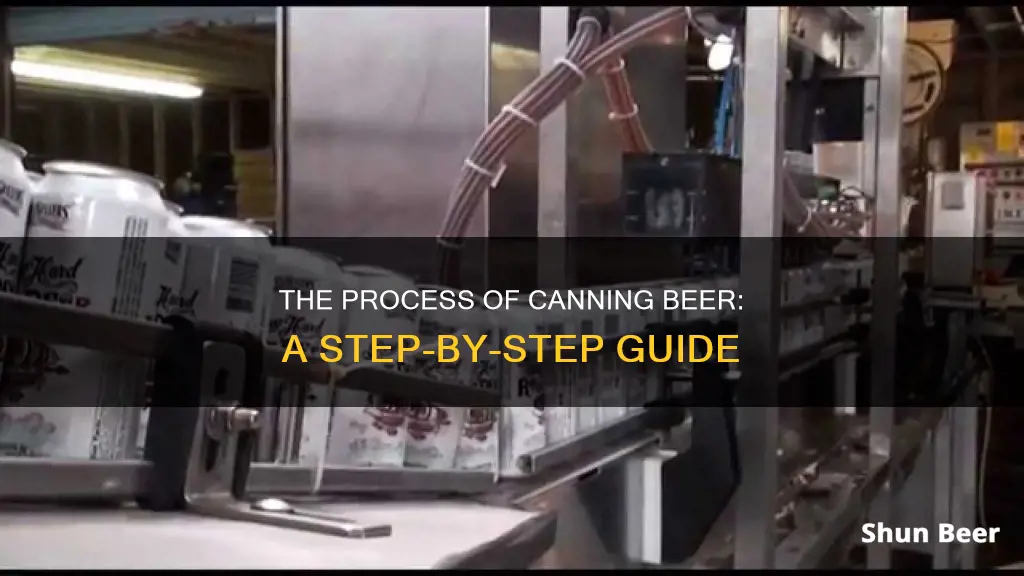
Beer canning is a complex process that has been refined over the years to ensure the perfect beverage for consumers. The process starts with empty aluminium cans being loaded onto a conveyor belt, either manually or through an automated system. The cans are then rinsed with sanitising water or a mild sanitiser to ensure they are clean, before being purged with carbon dioxide (CO2) to remove oxygen, which can negatively impact the beer's flavour and shelf life. After filling the cans with beer, lids are automatically placed on top, and a simultaneous burst of CO2 removes any remaining oxygen. The cans are then sealed through a process called seaming, where the lids are crimped onto the cans, either with a seaming machine or a can seamer and lid. Finally, the exterior of the cans are rinsed, and they are packaged for sale.
What You'll Learn

Empty cans are loaded into the machine
Automatic Canning
With a high-output automated canning system, the user will operate a machine called a depalletizer to load the cans in. The depalletizer removes the empty cans from their pallets and feeds them onto a conveyor belt in groups. This method is more efficient than manual canning and can handle a larger volume of cans. It is also important to note that the cans arrive on the conveyor belt without tops, as they need to be filled and sealed.
Manual Canning
For manual or semi-automatic canning systems, the operator will have to feed each empty can into the machine by hand. This process is more labour-intensive and time-consuming, and it may result in inconsistencies in the final product. However, it is a more affordable option for small or medium-sized breweries that cannot afford an automated system.
In both cases, the empty cans are typically made of aluminium and are pre-printed without tops. They are also thoroughly cleaned and sanitised before being filled to ensure the beer's quality and freshness. Additionally, the use of aluminium cans offers a 360-degree design space for breweries to showcase their branding and enhance their product's visual appeal.
Beer Slug Traps: Do They Work?
You may want to see also

The cans are rinsed and sanitised
There are several ways to sanitise beer cans, depending on the specific needs and preferences of the brewery. One common method is to use a mild sanitiser, which helps to eliminate any potential beer-spoiling microorganisms, such as lactobacillus, brettanomyces, and pediococcus. While this method is effective, it is important to consider the potential cons of pre-rinsing, as the residual water used in the process can also oxidise the beer.
Another option is to use deionised air, which is a more intense sanitising method that can effectively remove any impurities from the cans. This method may be preferred by breweries that prioritises an extremely thorough sanitising process, ensuring that their beer meets the highest standards of quality and freshness.
Some breweries may also choose to use UV-filtered water to rinse their cans. While this method can be effective in removing debris and sanitising the cans, it is important to consider the potential for oxidation. The residual water from the rinsing process can contain high levels of oxygen, which can negatively affect the beer's flavour and freshness. Therefore, this method is usually only employed when necessary, such as when the cans have been exposed to environmental factors like dust.
Overall, the rinsing and sanitising process is a critical step in beer canning, ensuring that the final product is safe, tasty, and fresh. By employing effective sanitising methods, breweries can maintain the quality and integrity of their beer, providing consumers with a pleasant and enjoyable drinking experience.
Beer Hair Wash: Does it Work?
You may want to see also

Oxygen is purged from the cans
Purging oxygen from beer cans is a critical step in the canning process, as any oxygen remaining in the can will negatively affect the beer's flavour and reduce its shelf life. Oxygen is the enemy of bright and expressive flavours in beer, causing staling, muting, and a reduction in shelf life. This process of oxidation occurs when molecular oxygen comes into contact with alcohol, turning alcohols into undesirable compounds called aldehydes. In beer, ethanol becomes acetaldehyde, which can be described as having a green apple, pumpkin, latex paint, or cut grass flavour.
After the initial purge, the cans are filled with beer, and the lids are placed on top. As the lid is lowered, another burst of CO2 is released, expelling any remaining oxygen from under the lid. This step ensures that no oxygen remains in the can, preserving the integrity of the beer.
To further prevent oxygen from entering the beer during the canning process, it is important to regularly replace tri-clamp gaskets, use properly sized Oetiker clamps on hoses, and implement proper purging procedures for the brite tank. These measures help to create a consistent, oxygen-free environment for the beer, ensuring that it reaches the consumer with the intended flavour and quality.
Millenials' Work Culture: Beer on the Job?
You may want to see also

The cans are filled with beer
Now for the main event. After the oxygen purging, the cans travel down the canning line, and it's time to fill them up. A Teflon tube descends from above and releases the beer into the cans. The number of cans filled at a time depends on the size and capacity of the filling station—the more filler heads in the machine, the more cans it can handle simultaneously. And since a little spillage is inevitable, most machines will overfill each can by a small amount.
But wait, there's more! The art of filling beer cans is a delicate balance. You see, every can needs some headspace. Too much headspace, and the beer can go flat. Too little, and you've got a "low fill," which can impact the customer's perception of your brand. It's a fine line to walk, but with careful monitoring and adjustments, it can be done.
And there you have it—the cans are filled with beer, and the journey towards that first refreshing sip is one step closer.
The Magic Behind Beer: A Brewery Tour
You may want to see also

The cans are sealed and seamed
Once the cans are filled with beer, the lids are automatically placed on top. As the lid drops, a simultaneous burst of CO2 pushes out the remaining oxygen from under the lid. This is a critical step as oxygen can negatively impact the beer's flavour and reduce its shelf life.
With the can now full and the lid in position, it moves down the line to the seamer. Each can is rotated, and a motor spins the can at high speed with a crimping seamer, sealing the lids on the cans. This process is called double seaming and it involves two "seaming rollers" that rotate around the can one after the other, crimping the end and the can together. The cans are filled, lidded, and seamed individually at a rate of up to 120 cans per minute.
The seaming component of canning is a precise, automated process that ensures the beer lids go onto the cans correctly by creating a hermetic (airtight) seal. The process is incredibly precise, involving tolerances of a thousandth of a millimetre. Larger-scale breweries use automated seam saws with microscopic cameras to inspect and measure the seams.
Beer as Petrol: Can You Really Run on Hops?
You may want to see also
Frequently asked questions
The process of beer canning involves loading empty cans onto a conveyor belt, rinsing them with sanitizing water or a mild sanitiser, purging them of oxygen with CO2, filling them with beer, sealing them with lids, and then rinsing, drying, labelling, and packaging the filled cans.
Oxygen can shorten the shelf life of beer and negatively impact its flavour, causing it to taste stale or muted.
Canning beer has several advantages over bottling, including reduced weight and shipping costs, lower chances of breakage, easier stackability, and the ability to completely block out light, which can cause beer to become skunky.
Some potential issues to be aware of during the beer canning process include oxygen pickup, which can lead to stale beer, incorrect fill levels, labelling mistakes, and secondary fermentation caused by bacteria such as lactobacillus and brettanomyces.







